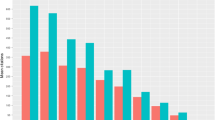Abstract
Journal impact factor (JIF) has been used for journal evaluation over a long time, but also accompanied by the continuing controversy. In this study, a new indicator, the Journal’s Integrated Impact Index (JIII) has been proposed for journal evaluation. In the JIII, one journal’s average citations per paper, total citations, and all journals’ average level of average citations per paper and total citations have been used to characterize the integrated impact of journals. Some contrastive analyses were carried out between JIII and JIF. The results show some interesting properties of the new indicator, and also reveal some relevant relationships among JIII, JIF, and other bibliometric indicators.

Similar content being viewed by others
References
Archanbault, E., & Lariviere, V. (2009). History of the journal impact factor: Contingencies and consequences. Scientometrics, 79(3), 635–649.
Bordons, M., Fernandez, M. T., & Gomez, I. (2002). Advantages and limitations in the use of impact factor measures for the assessment of research performance in a peripheral country. Scientometrics, 53(2), 195–206.
Braun, T., Glänzel, W., & Schubert, A. (2005). A Hirsch-type index for journals. The Scientist, 19(22), 8.
Braun, T., Glänzel, W., & Schubert, A. (2006). A Hirsch-type index for journals. Scientometrics, 69(1), 169–173.
Buela-Casal, G. (2004). Assessing the quality of articles and scientific journals: Proposal for weighted impact factor and quality index. Psychology in Spain, 8(1), 60–76.
Butler, D. (2008). Free Jouranl-ranking tool enters citation market. Nature, 451, 6.
Campanario, J. M. (1998). Peer review for journals as it stands today, part 1. Science Communication, 19(3), 181–211.
Della Sala, S., & Grawford, J. R. (2006). Impact factor as we know it handicaps neuropsychology and neuropasychologists. Cortex, 42(1), 1–2.
Egghe, L. (2006). Theory and practise of the g-index. Scientometrics, 69(1), 131–152.
Egghe, L. (2009). An econometric property of the g-index. Information Processing & Management, 45(4), 484–489.
Egghe, L., & Rousseau, R. (2002). A general framework for relative impact indicators. Canadian Journal of Information and Library Science, 27(1), 29–48.
Garfied, E. (1955). Citation index to science: a new dimension in documentation through association of ideas. Science, 122, 108–111.
Garfied, E. (1999). Journal impact factor: A brief review. Canadian Medical Association Journal, 161(8), 979–980.
Glänzel, W., & Moed, H. F. (2002). Journal impact measures in bibliometrics research. Scientometrics, 53(2), 171–193.
Guns, R., & Rousseau, R. (2009). Real and rational variants of the h-index and the g-index. Journal of Informetrics, 3(1), 64–71.
Hirsch, J. E. (2010). An index to quantify an individual’s scientific research output that takes into account the effect of multiple coauthorship. Scientometrics, 85(3), 741–754.
Hirsch, J. E., & Jorge, E. (2005). An index to quantify an individual’s scientific research output. Proceedings of the National Academy of Sciences of the United States of America, 102(46), 16569–16572.
Ingwersen, P., Larsen, B., Rousseau, R., & Russell, J. (2001). The publication-citation matrix and its derived quantities. Chinese Science Bulletin, 46(6), 524–528.
Iribarren-Maestro, I., Larsen, B., & Ingwersen, P. (2009). Research assessments by synchronic and diachronic citation impact: A case study of Carlos III University of Madrid. In Proceedings of the International Conference on Scientometrics and Informetrics (Vol. 1, pp. 487-491), Rio de Janeiro.
Leeuwen, Van., & Moed, T. N. (2002). Development and application of journal impact measures in the Dutch science system. Scientometrics, 53(2), 249–266.
Pinski, G., & Narin, F. (1976). Citation influence for journal aggregates of scientific publications: Theory with and application to the literature of physics. Information Processing and Management, 12, 297–312.
Ramirez, A. M., Garcia, E. O., & Del Rio, J. A. (2000). Renormalized impact factor. Scientometrics, 47(1), 3–9.
Schreiber, M. (2010a). How to modify the g-index for multi-authored manuscripts. Journal of Informetrics, 4(1), 42–54.
Schreiber, M. (2010b). A case study of the modified g index: Counting multi-author publications fractionally. Journal of Informetrics, 4(4), 636–643.
Schubert, A., & Glänzel, W. (2007). A systematic analysis of Hirsch-type indices for journals. Journal of Informetrics, 1(3), 179–184.
Sombatsompop, N., & Markpin, T. (2005). Making an equality of ISI impact factors for different subject fields. Journal of the American Society for Information Science and Technology, 56(7), 676–683.
Todeschini, R. (2011). The j-index: A new bibliometric index and multivariate comparisons between other common indices. Scientometrics, 87(3), 621–639.
Winkmann, G., Schlutius, S., & Schweim, H. (2002). Publication languages of impact factor journals and of medical bibliographic databanks. Deutsche Medizinische Wochenschrift, 127(4), 131–137.
Acknowledgments
We are grateful to the editors of Scientometrics and anonymous referees for their valuable comments and suggestions.
Author information
Authors and Affiliations
Corresponding author
Rights and permissions
About this article
Cite this article
Ma, T., Wang, GF., Dong, K. et al. The Journal’s Integrated Impact Index: a new indicator for journal evaluation. Scientometrics 90, 649–658 (2012). https://doi.org/10.1007/s11192-011-0538-z
Received:
Published:
Issue Date:
DOI: https://doi.org/10.1007/s11192-011-0538-z




